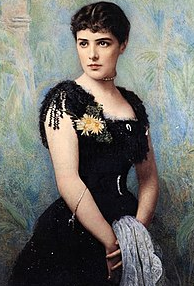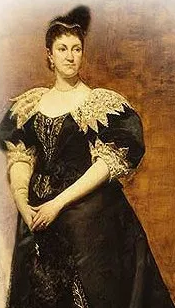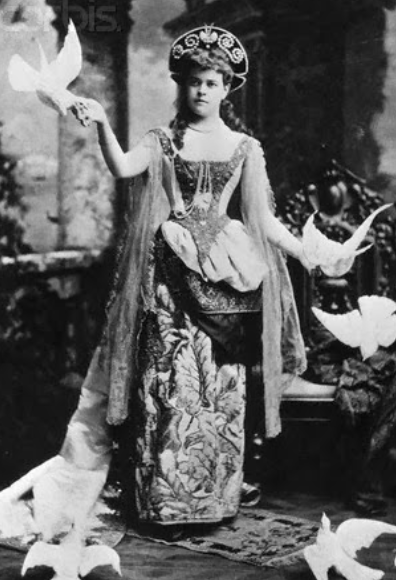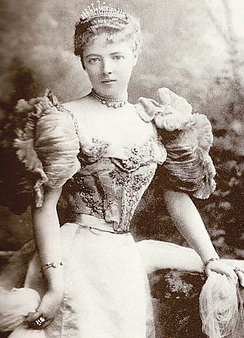Panthers on the Prowl in London Elizabeth Beare Reviews “The Husband Hunters: Social Climbing in London and New York” by Anne de Courcy
https://quadrant.org.au/magazine/
Prince Harry and Meghan Markle? Nothing new there really. Just catnip.
The daughters of the American rich who invaded London in quest of titled mates tended to be spirited and good company, not milksops like the general run of British debutantes. Whatever their other attractions, the ‘buccaneer belles’ have inspired a social history par excellence.
There I was, in an airport bookshop, seeking some entertainment for another long-haul flight, clutching a paperback that had looked promising on the shelf, and so it proved to be. The cover picture was enticing, a coloured-up photograph of an 1890s belle, displaying in pastels the porcelain skin, long straight nose, fine clear eyes and the pile of preferably auburn hair that was all the go at the time, the whole a cultural ensemble for feminine pulchritude, topped off with a bunch of pink peony roses dramatising her blue straw hat. Her neck swathed in a high fichu of fine white lace, the hint of an elegantly generous leg-of-mutton sleeve on her gown and her discreet stud-pearl earrings all said “lady”, but her vaguely eager expression suggested she might be fun nevertheless.
The blurb on the back told me that Libby Purves, in the Times Literary Supplement, had nominated this book as “pure catnip” for “both serious social historians and Downtonish aristo-fanciers”. A double-whammy for me—especially as this book of potted biographies of rich American women living in the decades before the First World War also contains a fascinating series of black-and-white, and some coloured, photographs of the life and times surrounding a very particular social phenomenon which is the book’s raison d’être. In The Husband Hunters Anne de Courcy puts a well-researched focus on the seeming invasion between 1870 and 1914 of young American heiresses into the cash-strapped marriage markets of Europe and Britain, where over 450 of them married titled Europeans, 100 of them British aristocrats, including six dukes, the best catches of all. The number of these marriages peaked in 1895.
This review appears in the latest Quadrant.
Click here to subscribe
These young women were heiresses to what the American novelist Edith Wharton in the 1880s termed the “buccaneer” wealth of America’s industrial capitalist expansion, a concentrated great wealth that lodged with the families of energetic (or lucky) entrepreneurs. The wives of these rich men bellowed out their husbands’ successes by spectacular displays of conspicuous consumption in housing, jewellery, carriages and other embellishments in an attempt to make the restricted invitation lists put out by the similarly profligate and display-prone female guardians of Old Money status, who were dropping their old habits of frugality and prudence in the race to keep their pre-eminent social position against such new contenders. In New York (whence many of the girls came) “the list” meant Mrs Astor’s list, and later Mrs Vanderbilt’s. As nouveau riche girls, frequently short on social status at home, they suffered from their mothers’ intent on remedying that deficit for themselves as well as their daughters, by means of a title which would carry Mamma along with her daughter into Mrs Astor’s ballrooms (pictured below) on any return to New York. Thus by a combination of circumstances at home, American heiresses to this amazing financial bounty brought their money and often their vigour to the titled men of Old Europe, careworn by the requirement of maintaining the ancestral pile and their own familial status and lifestyle during a major economic downturn.
 Paris was a favourite initial destination in which to find one’s feet for a later shot at British husband hunting, for the continent had laxer behavioural codes, blooding the New World ingenue for the coming steep learning curve in the more taxing social mores of Britain. However, while this book covers some interesting continental opportunities taken, its main exposition relates primarily to Britain and the Anglophone relationship being cemented by the new White Star Line Atlantic “crossing’, a voyage which, now carrying this book, I was myself just on my way to reprise from New York to Southampton, on the modern Queen Mary; a nostalgic look backwards for today’s boomer generation.
Paris was a favourite initial destination in which to find one’s feet for a later shot at British husband hunting, for the continent had laxer behavioural codes, blooding the New World ingenue for the coming steep learning curve in the more taxing social mores of Britain. However, while this book covers some interesting continental opportunities taken, its main exposition relates primarily to Britain and the Anglophone relationship being cemented by the new White Star Line Atlantic “crossing’, a voyage which, now carrying this book, I was myself just on my way to reprise from New York to Southampton, on the modern Queen Mary; a nostalgic look backwards for today’s boomer generation.
These newcomers, smart American girls, better educated, more fashionably nip-waist dressed by the must-have Parisian designer Wirth, and more politically savvy than their sheltered British competitors in romance, also tended to be healthier, and more forthright in personality. They were good company at dinner, not milksops like the general run of British debutantes, who, suggests de Courcy, were essentially trained to do the flowers in a great country house, but for not much else. Not surprisingly, the men often fell deeply in love with an American newcomer, in thrall to the excitement of the chase as well as to a relieving “financial settlement”. As Americans in Britain, the girls’ manners were all lumped into the same “foreigner” category, escaping the finer discriminations against parvenus made back home in the United States.
This unitary categorisation also opened the field to them in Britain by dismissing the tyranny of accent prevailing in Britain for locals, that great class signifier of origin for the wealthy girls from Britain’s industrial north, who were largely discounted as aristocratic wives due to speech, manners and a too readily accessible trail of embarrassing relatives. Luckily for the American girls, British aristocrats saw all American accents as “southern” and acceptable, as many aristocratic younger sons had ventured to the land of mint juleps to seek their fortune. And embarrassing American Mammas did eventually return home. British girls too were doubly disadvantaged as so few of them were heiresses, with the family property often entailed to a girl’s brother, or a male cousin (the foundation storyline in Downton Abbey) and few spare funds left for them. So there was no holding the Americans back once they arrived, clearly ready and able to pay for their entry to British society, their manners seen as “refreshing”, not inferior. Well-connected aristocratic ladies of diminished means discreetly provided introductory favours, for a consideration. For this is the way the world works; “follow the money” was, as ever, still a useful mantra, except it seems with Mrs Astor.
 In this book we sense Downton Abbey’s fictional Countess of Grantham, Cora the good-hearted American and her dreadful rich mother in that series, with a sampling of mothers and daughters here examined in real life. Mary Leiter, for example, an American belle who snatched away the eligible Lord Curzon (the happy couple pictured at right), later Viceroy to India, had a mother known for malapropisms. When told Mary may be too delicate to sit in the night air, Mrs Leiter replied that her daughter was “one of the most indelicate girls you ever knew”. Also in this book we find the doyenne of the husband-hunter genre, the beautiful and witty American Jenny Jerome (below left), daughter of a dubious “flamboyant” sporting financier, who married “for love” a son of the Duke of Marlborough against the Duke’s wishes, thus becoming Lady Randolph Churchill and, eventually, mother of Winston. She took London in a season, and reigned for longer, “more panther than woman”, it was said, with photographs in the book that prove it.
In this book we sense Downton Abbey’s fictional Countess of Grantham, Cora the good-hearted American and her dreadful rich mother in that series, with a sampling of mothers and daughters here examined in real life. Mary Leiter, for example, an American belle who snatched away the eligible Lord Curzon (the happy couple pictured at right), later Viceroy to India, had a mother known for malapropisms. When told Mary may be too delicate to sit in the night air, Mrs Leiter replied that her daughter was “one of the most indelicate girls you ever knew”. Also in this book we find the doyenne of the husband-hunter genre, the beautiful and witty American Jenny Jerome (below left), daughter of a dubious “flamboyant” sporting financier, who married “for love” a son of the Duke of Marlborough against the Duke’s wishes, thus becoming Lady Randolph Churchill and, eventually, mother of Winston. She took London in a season, and reigned for longer, “more panther than woman”, it was said, with photographs in the book that prove it.
 It is a truism that we live our lives drawn hither and yon by the economic tides of our times. Top of mind in this period also, given the dismal opportunities open for women’s independence, unchanged since acerbically noted by Jane Austen in the well-known obsession of Mrs Bennet, was the belief that all daughters stood in need of a husband of proper status and that it was their mother’s job to help land him. In terms of circumstance, this American tide of young heiresses, their mothers, and the men that they married were, as Shakespeare puts it, taken at the flood. Anne de Courcy sketches out the socio-financial background of the invasion well for the reader in the introduction and the conclusion. Her biographical chapters then provide accounts of the individual circumstances that composed the whole complex economic and social mosaic. It is social history par excellence; she never loses sight of the personal element in each small tile of it, the acute observations of style, fashion and human venality or its more pleasant opposite, while keeping this mosaic related to the broader drivers of its composition.
It is a truism that we live our lives drawn hither and yon by the economic tides of our times. Top of mind in this period also, given the dismal opportunities open for women’s independence, unchanged since acerbically noted by Jane Austen in the well-known obsession of Mrs Bennet, was the belief that all daughters stood in need of a husband of proper status and that it was their mother’s job to help land him. In terms of circumstance, this American tide of young heiresses, their mothers, and the men that they married were, as Shakespeare puts it, taken at the flood. Anne de Courcy sketches out the socio-financial background of the invasion well for the reader in the introduction and the conclusion. Her biographical chapters then provide accounts of the individual circumstances that composed the whole complex economic and social mosaic. It is social history par excellence; she never loses sight of the personal element in each small tile of it, the acute observations of style, fashion and human venality or its more pleasant opposite, while keeping this mosaic related to the broader drivers of its composition.
 The main driver for the girls and their mothers was the very closed nature of New York society under Mrs Astor (at right), where only four hundred old families were acceptable. As Hayek reminds us, closed societies will always stagnate until they give way. In New York, this closure was a strong push factor for the girls’ entry to Britain, for wealth has ever required social validation as well as standing proxy for self-identity: “I spend therefore I am,” suggests de Courcy about the hyper-extravagance reached by the 1890s. Status put-downs loomed cruelly large for some:
The main driver for the girls and their mothers was the very closed nature of New York society under Mrs Astor (at right), where only four hundred old families were acceptable. As Hayek reminds us, closed societies will always stagnate until they give way. In New York, this closure was a strong push factor for the girls’ entry to Britain, for wealth has ever required social validation as well as standing proxy for self-identity: “I spend therefore I am,” suggests de Courcy about the hyper-extravagance reached by the 1890s. Status put-downs loomed cruelly large for some:
Fifth Avenue and Newport’s Bellevue Avenue were lined with huge, ornate mansions built by the new plutocrats that offended the old-school upper crust. When one of these nouveau hostesses announced, “And this is my Louis Quinze salon!” Mamie Stuyvesant Fish, a woman known for her rather acid frankness responded, “And what makes you think so?”
Similarly, “He had a coat of arms, a very grand one, brand-new besides, not a second hand one,” wrote one wag in barbed mode. The search for a real one was thus balm to many wounded Mammas. The attractions of European “heritage”, with real titles available due to the penurious state of aristocratic fortunes, provided the strong pull factor for these ambitious Mammas trailing their young moneyed girls. Access to royalty was also a plus, provided not just through aristocratic networks but directly, in the ebullient corporeal form of the gluttonous Prince of Wales, who loved the spontaneity, and availability, of beautiful American women richly gathered at yachting central, Cowes on the Isle of Wight, and damn what his own Mamma, Queen Victoria, thought.
The drivers for the aristocratic males were linked to factors that also caused the 1890s depression, which is not really covered in this book, although the effect of social changes in land tenure and the decline in aristocratic property income are shown to be stressors, leading to a breakdown of some aristocratic marital traditions. British law giving married women only limited rights to property ownership, vesting their dowries into their husbands’ control, was also important. The Prince of Wales also significantly beggared more than a few by his peripatetic wanderings among the aristocratic great houses, requiring tremendous outlays to keep him and his retinue fed, watered and entertained in royal style.
 De Courcy examines with sympathetic fairness how the invasion and the values it espoused were a toxic brew for some of the young heiresses, who resisted the pressure towards an advantageous (for Mamma) marriage, only to be dragooned to the altar by threats and cajolery, as we see in the account of the rise of Mrs Alva Vanderbilt (at left):
De Courcy examines with sympathetic fairness how the invasion and the values it espoused were a toxic brew for some of the young heiresses, who resisted the pressure towards an advantageous (for Mamma) marriage, only to be dragooned to the altar by threats and cajolery, as we see in the account of the rise of Mrs Alva Vanderbilt (at left):
Alva Vanderbilt, sexy, aggressive, iron-willed, was the supreme embodiment of both husband-hunter and social climber, first pulling her family into the higher echelons of American society through strategic moves and then forcing her daughter into marriage with a high-ranking nobleman whom she herself had tracked down and marked as a quarry, to ensure and maintain her own high status position.
That nobleman was the Duke of Marlborough, very much in need of a rich wife, becoming the first duke netted by an American heiress. Alva’s daughter Consuelo, however, just eighteen, had other ideas; she had fallen in love with someone else, at which news Alva imprisoned her daughter in the gilded cage of Marble House, the grand family pile in high-society Newport, until, like a medieval entowered princess, Consuelo acceded to the familial arrangements for her dowry and accepted the Duke’s suit. For Alva had run a tight ship. Guarded by porters at the doors, never without her mother or a governess present, out of contact, with no way of sending a message to her lover, and psychologically constrained since babyhood to obey her domineering Mamma, Consuelo was defeated. On the  morning of her marriage in 1895, she cried so much the wedding was delayed to conceal signs of her weeping, a footman posted at the door to foil any last-minute attempt to escape.
morning of her marriage in 1895, she cried so much the wedding was delayed to conceal signs of her weeping, a footman posted at the door to foil any last-minute attempt to escape.
The invading American heiress Maud Burke (at right), we are told, when it came to British society, “could hardly get enough of it”. Maud reinvented herself from unlikely beginnings, her constructed biography and origins made more possible when all family records were lost in the San Francisco earthquake. Newly rich and unknown previously, as an American “belle”, where beauty trumped origins, she became one of England’s most famous hostesses, at one stage taking the conductor Sir Thomas Beecham as her lover, funding and encouraging English opera and bringing in famous singers as respectable dinner companions (shades of Downton Abbey’s episode featuring the scandalous dining at Downton of Nellie Melba).
For Maud in particular de Courcy suggests that “the acquisition of a titled English husband was not only a stepping stone but a way of showing how little she cared about a public jilting”. Impetuously, Maud had prematurely announced her engagement to Prince Andre Poniatowski, the grandson of the late King of Poland, before the Prince had fully firmed up his friendship with her. In the event, he turned his affections to a richer marital possibility, and Maud was forced to make a humiliating public retraction. Attractive to men, Maud soon married her baronet, an older man, the heir to the Cunard fortune and title. Faithful until the birth of her daughter, the infant discarded then to servants, Maud threw herself into launching a career as a society hostess, becoming a good friend of the Prince of Wales and other gentlemen, her marriage on permanent hold. She was recalled by one faithful lover for her “mien and motion … How I live for memories of Maud”. In a world where it was believed by some women that in matters of the bedroom “ladies never move’”, one suspects this is a maxim Maud never took to heart.
This invasion was a transatlantic exchange that suited both sides. It jabbed a hole into stuffy New York resistance to new money, making the old status barriers eventually seem dated. By 1909 new forms of expressing social achievement were also gaining prominence. Amy Vanderbilt’s Political Equality League for Women in 1909 gave high visibility to new forms of virtue seeking, with Consuelo Marlborough declaring, “A purely social life has no appeal,” an impossible thought only fifteen years earlier. The beginnings of today’s wealthy celebs, social justice warriors all, can be traced back to here. The growth of the mass media newspapers also helped democratise the times, condemnatory of Gilded Age excesses and profligate spending, while having spent the previous thirty years reporting on it with considerable gusto.
In Britain, the American wives exerted a cultural effect that de Courcy claims, probably correctly, was out of proportion to their actual numbers, on both the aristocracy and the broader British society. English women were able to take their cues from the Americans and lead less formal lives. Key American wives forged ahead in Parliament (Nancy Astor became England’s first female Member of Parliament) and as intellectual hostesses, in the dinners and salons they presided over. American newspapers resented the flight of huge amounts of American capital to Britain in what they satirised as “Cash for Coronets”, but this capital gave Britain an enduring legacy. Many country house estates were retained, rescued from disrepair by restoration, and there was an influx of European art treasures with which to stock them, saving this heritage for posterity.
For a while, dowries running up to $20 million meant more servants were employed on such estates for show in many new designations: gamekeepers, cricket coaches, lodge-keepers and footmen; and also many tradesmen to update these places. Mary Leiter’s American money eventually helped George Curzon become Viceroy of India. Using letters, diaries, memoirs and interviews, de Courcy presents for us a vividly real-life Downton Abbey through sharp anecdotes and extensive details, in which English aristocrats show that they too could encompass “progress” in a peculiarly aristocratic manner. So when the Dowager Countess of Grantham, in Downton Abbey, finds it incumbent upon herself to include the new son-in-law, previously the chauffeur, into the family, she invents a likely lineage for him in Ireland. American wives too showed they could cope with the strictures of British country life, its dogs, its routines, its royalty.
Elizabeth Beare lives in Sydney. She wrote “Decoding King Arthur and the Grail” in the September issue.
Comments are closed.
